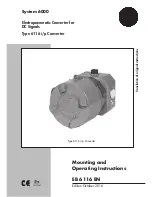
15
4. Press the Mac Syncman Write switch. This starts Mac Syncman out-
putting a SMPTE signal which will be indicated by the Write LED
going on.
5. Adjust your recording level to around
- 5 dB
.
6. Continue recording several minutes of SMPTE stripe. Naturally, you
will need a stripe longer than the piece you are going to sync.
7. When done recording the stripe, again press the Mac Syncman Write
switch.
8. Take your tape recorder out of record.
9. Rewind your tape to just before where you started recording the
sync stripe.
That’s it — that’s all there is to recording a SMPTE stripe. You now have
a SMPTE stripe to sync to.
If you are using an older version of Performer which uses Direct Lock
(older than v 3.3), turn the DTL/MTC dip-switch Up. However, if not
using Performer make sure the DTL/MTC switch is Up.
NOTE: Mac Syncman transmits MIDI Time Code when the SMPTE
stripe is being written (as well as when it is being read). This means
you can easily trouble shoot any MIDI Time Code capable sequencer
without having to go to tape. This is done by simply pressing the
Write switch on Mac Syncman, generating MIDI Time Code into your
sequencer and debugging it.
To check the integrity of your sync tone, rewind the tape to somewhere
before where you started to record the tone. Make sure your Mac
Syncman is not in Write Mode and that the Tape Read/Write Indicator is
Off before you try playing back the tone. Now, press play on your tape
deck. When you reach the location on the tape where you began record-
ing the sync tone, the Tape Read/Write Indicator will light, showing that
a Mac Syncman sync signal is being read from tape. For the most reliable
performance, you should play the entire stripe back and make sure the
Read/Write Light never blinks.
When playing back the sync stripe, the tape light should never flicker. If
it does make sure your heads are clean, all of your cables are good, all
EQ (if you have gone through a mixing board) is flat, and that your tape
is good. After doing this try re-recording the sync stripe.










































